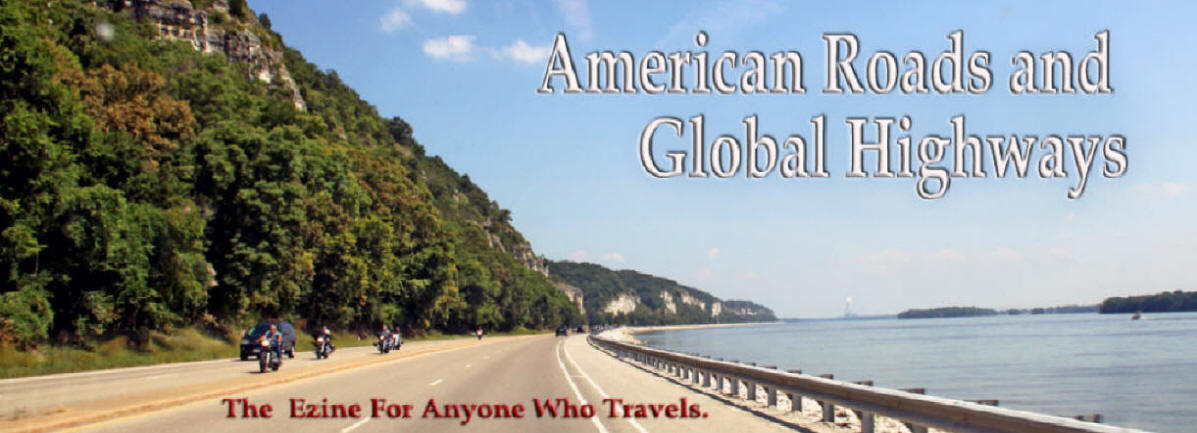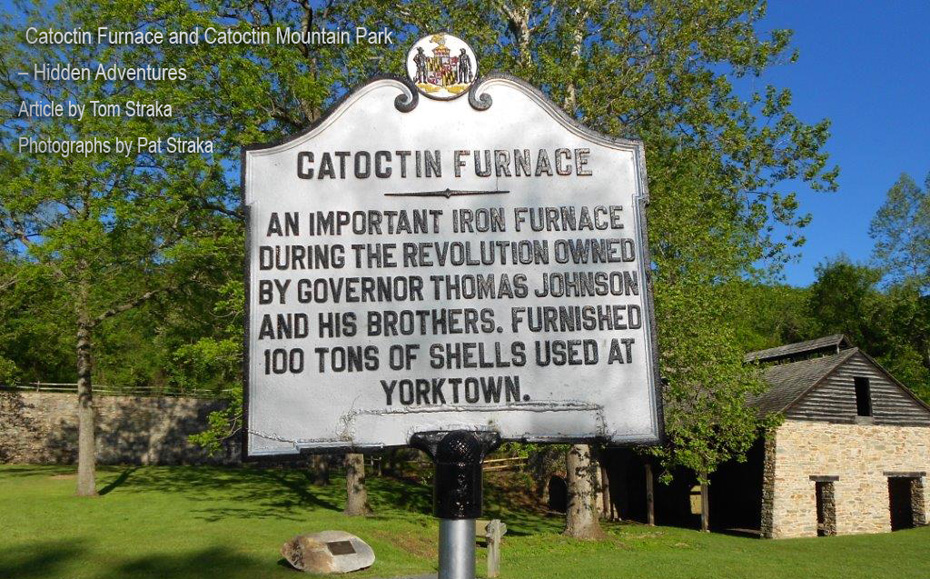
|
|
|
|
|
|
|
|
|
|
Sometimes you stumble on fascinating road trips. We stumbled on one between the Antietam and Gettysburg Battlefields. The hour drive between the two battlefields passes through Catoctin Mountain Park in Maryland, a federal recreation area managed by the National Park Service. The map shows it
is really two parks: the federal one on the north and
contiguous Cunningham Falls State Park to the south.
Further research yielded a reason the park is not so
well-known; it's where they "hide" Camp David. Of
course, Camp David can't be visited, but the curious can
drive by the side road that leads to the president's
retreat. While you won't be able to see Camp David you
will be able to learn some interesting history on
conservation and how cut-over forest and unproductive
farm land ended up as a park. You'll learn there are
lots of other parks around the country that share the
same history. The state park on the
south provides the historical basis of the park:
Catoctin Iron Furnace. Iron furnaces are an interesting
part of American industrial history; they are scattered
across the Mid-Atlantic States and many have their own
engaging histories. Catoctin Furnace is one of those. It
dates back to the American Revolution and contributed
iron to that war. The furnace was fueled by charcoal and
the timber to make the charcoal came from the forests on
Catoctin Mountain. So forest history is part of the
park's background.
The "Isabella" furnace,
the second of three furnaces constructed at the site
still stands and is in a well-maintained area with a
trail that identifies interesting remnants of the old
charcoal iron furnace community. Near the furnace,
portions of the old village that supported the furnace
remain, and provide engaging background on how the
iron-making community lived. Some local history claims
that cannonballs used at Yorktown in the Revolutionary
War were produced here, and that iron from the furnace
was used to produce plates that were used on the USS
Monitor in the Civil War. Both claims are unlikely, but
the furnace was producing iron during both time periods,
so the claims are in the realms of possibility.
That Catoctin Furnace's iron was used in the Revolution
is well-established, but probably not in those
cannonballs.
The Catoctin Furnace trail
invites visitors to "step back in time on this ¼ mile
self-guided interpretative trail and catch a glimpse of
the iron industry in Frederick County." The trail
includes the foundation of the ironmasters house and
there is just enough left to show how impressive the
manor must have been. The ironmasters manor overlooked
the furnace and the massive size indicated how important
his positon was. In the nearby village, furnace laborers
lived in single room houses (some of which still
remain). There is a slag pile (looking like very
black rocks), as expected at an iron furnace (the
by-products had to go somewhere). Remains of the
raceway and dam that supplied water to the waterwheel
that powered the bellows for the furnace are along the
trail. The trail includes two interesting bridges,
Bowstring Arch Bridge that crosses Little Hunting Creek
(built in 1872 and later moved to the trail), and a
larger one that crosses the nearby US highway and leads
into the state park.
There are interpretative
signs related to the Civil War on the site. The furnace
never stopped production during the Civil War and
federal troops marched by the furnace on the way to
Gettysburg and "according to local tradition, lost and
disoriented soldiers from both sides making their way
south after the Battle of Gettysburg were offered jobs
here because of the chronic labor shortage." Catoctin Mountain Park is
north of the state park and furnace. It is administered
by the National Park Service. It is not a national park,
but is run like one. It probably only exists because of
Camp David. During the Great Depression one of the
conservation/relief efforts was called the Land
Utilization Program. Unproductive farmland that was not
doing much more than causing soil erosion was purchased
by the federal government and the farmers were moved to
more productive farms. These lands were developed into
conservation projects and eventually most were
transferred to state ownership. Many of the projects
became state parks and were first managed as
recreational demonstration areas. This was Catoctin
Recreational Demonstration Area under the program.
President Roosevelt needed a place to spend parts of hot
summers close to Washington, DC and chose a Camp
Shangri-La in the recreational area. This became Camp
David under President Eisenhower. The visitor center
contains information on this part of New Deal history. The visitor center also
contains history on the iron industry in the area and
its impact on the surrounding forest. Other
displays center on the rural community that once existed
here and other local industries (like moonshining and
sawmilling). The park is full of hiking trails and high
vistas. But some of the shorter trails relate to the
themes in the visitor center. The Charcoal Trail
illustrates the impact of the charcoal production
industry on the forest and includes many of the sites a
visitor would have seen on the forest in the nineteenth
century. This trail has old charcoal hearths (charcoal
production sites), stacks of billets (wood used in
charcoal production), a collier hut (small shelters
built by charcoal makers who had to live in the woods),
and a replica of a wooden sled that was used to
transport wood to the hearths.
The Blue Blazes Whiskey
Trail is 0.6 miles long and follows the Blue Blazes Run.
Many stills operated in the area. This trail leads to an
infamous one, of commercial size, that operated during
the 1920s Prohibition Era. Farmers needed a cheap way to
get their grain to market, and transporting whiskey was
much easier than transporting the heavy grain.
Unlike the small stills a farmer might use, the Blue
Blazes Whiskey Still was so large that it supplied
Baltimore, Philadelphia, and Washington, DC. There is
information along the trail on raids that took place at
local stills (including one that cost a deputy sheriff
his life). A second trail leads to a water-powered
sawmill. Visitors can get up close and see the mill
mechanisms and logs about to be sawn. This is a park
that provides some wonderful opportunities to explore a
beautiful forest while learning about some local forest
history.
The visitor center does an
excellent job of tying the forest history together with
the New Deal programs (like the Works Progress
Administration and the Civilian Conservation Corps) that
established the park. It is the place to start a tour of
the park as it puts much of this history into context.
Like
Camp David that is hidden in the park, the park itself
is a hidden jewel. We discovered it while traversing
between Antietam and Gettysburg. It's a wonderful way to
break up the trip between the two battlefields.
Authors: Thomas J. Straka is a forestry professor at Clemson University in South Carolina. His wife, Patricia, is a consulting forester. Both have a keen interest in history.
For more
information: Catoctin Furnace History http://www.catoctinfurnace.org/home/catoctinfurnacehistory.html Cunningham Falls State Park – Catoctin Furnace http://dnr.maryland.gov/publiclands/pages/western/cunningham.aspx National Park Service - Catoctin Mountain Park |
Connect with us on:
American Roads and | ||||||||||||||||||||
|
Public Disclosure--
Please Read I recently learned of a FTC law requiring web sites to let their readers know if any of the stories are "sponsored" or compensated. American Roads and Global Highways' feature writers are professional travel writers. As such we are frequently invited on press trips, also called fam trips. Most of the articles here are results of these trips. On these trips most of our lodging, dining, admissions fees and often plane fare are covered by the city or firm hosting the trip. It is an opportunity to visit places we might not otherwise be able to visit and bring you a great story. However, no one tells us what to write about those places. All opinions are 100% those of the author of that feature column. |
|||||||||||||||||||||
|
Privacy Policy/ Archives /
Contributors /
Subscribe to
American Roads Books by
Kathleen Walls /
Contact /
Sponsor or Advertise/ American Roads & Global Highways Home Page
|







